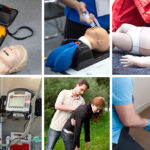The Pediatric Advanced Life Support (PALS) skills test and checklist are optional exams that can be taken in conjunction with the PALS certification. Pediatric patients in respiratory distress, failure, or shock should be assessed using an evaluation model and an assessment technique recommended by the American Heart Association and the American Academy of Pediatrics.
A series of films and simulated pediatric crises are included in our PALS course to help students better understand the need for a systematic approach to pediatric evaluation as well as basic life support, the PALS treatment algorithms, successful resuscitation, and team dynamics.
Upon completion, a student will be presented with a series of situations involving pediatric patients who are experiencing cardiopulmonary emergencies during the live session. This hands-on demonstration of your mastery of several of the online course’s skill sets comprises the PALS skills session.
The student must demonstrate proper decision-making and mechanics in PALS in accordance with current worldwide CPR and ECC recommendations and standards. Before attempting the live PALS skills test, it is important that the student is trained using the latest guidelines and displays an in-depth understanding of the critical processes involved in CPR in children and infants.
Evaluating the PALS Skills Checklist
The PALS skills checklist is utilized during an examinee’s optional hands-on evaluation. Comprehensive guidelines are given to both the test administrator and the student to aid in the facilitation of a standardized examination process. As the test administrator progresses through the megacode scenarios, they will check off items on the PALS skills checklist.
Medical students and trainees utilize a megacode to practice cardiac arrest and resuscitation. Students can learn how to deal with cardiac crises, respiratory failure, and resuscitation in a safe and controlled environment. Once the student has properly completed the PALS skills checklist, the test administrator will sign it.
PALS Skills Test — What’s on It?
All of the major cardiac and respiratory arrests, shock, and arrhythmias will be practiced in a variety of PALS scenarios. Instant feedback will be provided after completing a scenario in the PALS simulator. Practicing the PALS Algorithms will help you better respond to pediatric emergencies and reinforce your knowledge of them.
You can take each scenario as many times as necessary to master the PALS Algorithm if you so desire. After that, the student must attach the signed skills checklist to their PALS provider card as proof of completion. A current qualified PALS provider must conduct the PALS skills test. The examiner is responsible for reading the case scenarios to the examinee orally and then marks each appropriate step on the checklist as Complete or Incomplete as the examinee finishes each stage in a scenario.
Items must be completed correctly without assistance. If the examinee requires assistance while completing a step, the step must be marked as Incomplete, and the skills test redone. Beyond the directions in italics, no extra instruction should be offered to the examinee. Prior to retesting, areas that require improvement should be evaluated. Finally, each scenario should take around ten minutes to complete.
Example Scenario and PALS Skills Checklist
Let’s look at a scenario and associated PALS skills checklist you may encounter during your test:
Your team is summoned to a 7-year-old boy having a seizure. 
- Examine the airways, lungs, and circulation. You see there is no response, a weak pulse, and decreased respiratory effort.
- Perform the following in order: maintain airway, give supplemental oxygen, place cardiac monitor, BP cuff, pulse oximetry, start IV, and place defibrillation pads. You note the patient vitals are HR 44, BP 84/52, RR 8, spO2 75%, temp 99.9F. The heart monitor displays a rhythm indicating sinus bradycardia.
- The examinee properly identifies the patient’s heart rhythm.
- The examinee identifies the right intervention: non-rebreather mask oxygenation/ventilation. Despite oxygenation and ventilation, the patient’s perfusion is poor: HR 58, spO2 85%, BP 84/56.
- Start CPR to treat bradycardia. Bradycardia persists.
- Performs 15:2 CPR for 10 cycles, or approximately two minutes.
- Administer epinephrine in the correct dose of 0.01mg/kg, every 3-5 minutes. The monitor shows the following rhythm when there is no pulse.
- Detect pulseless arrest and shockable rhythm.
- Deliver initial shock, verbalize right dose of 2 J/kg.
- Ensure everyone is clear.
- Perform two minutes of CPR after shock. The patient spontaneously returns to circulation during the next rhythm check. Consider a fluid bolus, monitor and treat seizures, and optimize ventilation/oxygenation post-arrest.
Why Learn PALS with ACCA
PALS is an advanced resuscitation training program for the recognition and response of cardiac arrest or other cardiovascular emergencies in young patients. Your skills will be put to the test, and it is essential that you learn from study material that is accessible, easy-to-remember, and most importantly, informative and updated to reflect the ever-changing guidelines.
We provide a PALS certification training for medical professionals who work in pediatric emergency care and have to deal with critically sick infants and children. The PALS training is beneficial for medical professionals who work in pediatric emergency medicine, emergency response services, intensive care units, critical care units, and pediatric surgeons and physicians. In order to perform PALS effectively, you need to complete our online PALS course.
Conclusion
Our PALS course is designed and developed by a medical doctor, ensuring that you are receiving the most up-to-date, accurate, and highest quality course possible. Contact us today to enroll in our affordable PALS classes.







